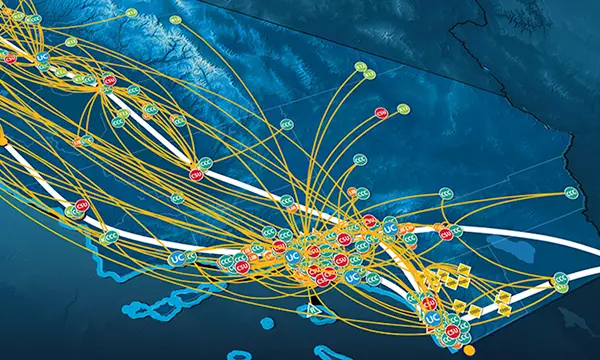- About
- Network
- Community
- Initiatives
- News
- Events
- Blog
- Publications

Transformed Infrastructure for Sustained Network Connections at SC22
Categories RENS & NRENS Pacific Wave Technology & Innovation

Over the years, the International Conference for High Performance Computing, Networking, Storage, and Analysis has provided an important venue for CENIC and its collaborative colleagues to demonstrate the latest in global networking technique and prowess. Each year, networking engineers from CENIC and its partners spend weeks devising critical infrastructure to enable a range of demonstration projects, dedicating nearly eighty percent of the effort to building the network infrastructure for the demonstrations, with the demonstrations themselves receiving twenty percent of the focus.
That distribution of effort was forever shifted with a few innovative decisions resulting from the SC21 conference that retained the network infrastructure developed in support of dynamic, multi-domain path provisioning developed for the event. And those decisions are already having an impact on planning for SC22.
“We made the decision to retain the network infrastructure in place beyond SC21 to enable ongoing persistent provisioning across the multiple domains established for SC21,” said Louis Fox, President and CEO of CENIC. “Our engineers realized this as a smart and sustainable option as this has become a production standard for our members. Keeping the infrastructure facilitatedby CENIC beyond the SC21 conference for an additional six months, gives our members a comfortable window to work with our engineers on a smooth transition of the infrastructure facilitated by CENIC to permanent infrastructure, with no impact on the next milestones: enhancing monitoring and evaluating of the dynamically provisioned paths, and expanding participating domains through the next year of outreach.”
One of the more significant users of high-end networking is Professor Harvey Newman, the Marvin L. Goldberger professor of physics at Caltech. He saw SC21 as a major milestone in the persistent trajectory of network development towards the services and new technologies that will change the way data intensive sciences can be done.
“If it weren’t for CENIC support for retaining this network, then the whole effort for moving to the next stage of development couldn’t happen,” said Newman. “But the vitality of a field depends on the rate at which knowledge is created, so it’s intrinsic to our success that things are consistently being developed. The great enabler right now is to have a system that supports change and that’s what this network does.”
Among the demonstrations CENIC supported that Newman finds important to the future was N-DISE: NDN (Named Data Networking) for Data Intensive Science Experiments focused on accelerating the pace of breakthroughs and innovations in fields such as the Large Hadron Collider high energy physics program and the BioGenome and human genome projects. Utilizing a data-centric future Internet architecture called Named Data Networking, or NDN, the demonstration showed throughputs of 12 to 16 gigabits per second on the testbed developed for the conference.

Since November, with the network still in place, researchers have improved the system and are up to 21 gigabits per second, according to Lead PI of the N-DISE project and Northeastern University electrical and computer engineering professor Edmund Yeh.
“Having this type of long-term relationship is truly helpful to science,” said Yeh, who noted that he has been involved with Newman and the CENIC team for nearly five years. “In SC18 we did a demo that showed the feasibility of our NDN system. SC19 showed that NDN could operate at 6.7 gigabits per second and look where we are now.”
Both researchers noted that collaboration and relationships are essential to get this work done.
“NDN is an idea which is very well suited for big data science applications such as high energy physics and genomics," said Yeh. “It's the idea that the network can name data and locate requested data, facilitate data transport and storage based on names, enable computations on and extraction of knowledge from the data, without associating data with specific conversations between machines."
Newman also noted that the partnership with the SENSE project, deploying virtual circuits, as well as the SENSE/AutoGOLE testbed which is expanding around the world, have a truly global reach.
“This worldwide persistent infrastructure, supported by CENIC, Pacific Wave, Internet 2, ESNet along with Caltech and UCSD and others, puts us on an important trajectory of development towards services and new technologies that will definitely change the way data intensive sciences can be done.”
Both scientists said they’re looking forward to leveraging the transformed infrastructure of the past year, including CENIC’s move to 400G and similar upgrades in ESNet and Internet 2.
“We need good networks to enable learning from all that data,” said Yeh. “Building data centric networking ecosystems – from naming of data, indexing the data, to discovering the data, to securing the data, to moving and storing the data, and then to perform computations on that data – all so the network can enable learning. That’s what you get from these unique interdisciplinary collaborations of a computer engineer working with a physicist.”
Related blog posts
The Big Game Is Big Data: How CENIC and the California Research and Education Network Support Member Athletics
When Fresno State needed to connect to Pac-12 Enterprises to broadcast a live football game over CBS, the Chancellor's Office reached out to CENIC for what Pac-12 later called the smoothest turn-up they've ever experienced.
Enabling Network-Based Collaboration Around the World: A Tour of CENIC and Partner Network Maps
On the Network Maps page at the CENIC website, you’ll find maps of all the networks, peering facilities, and exchanges to which CalREN connects, showing how thousands of CENIC member institutions connect to CalREN and to colleagues all over the globe.


